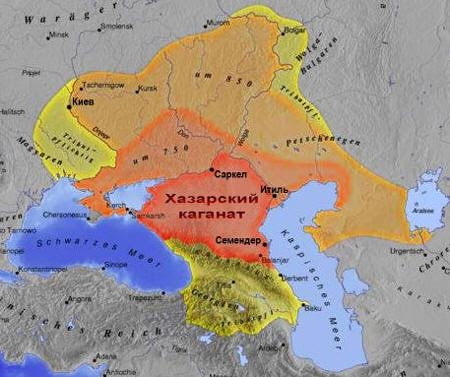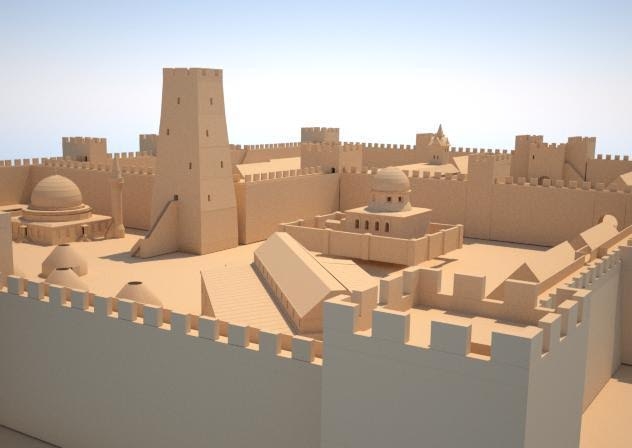The first evidences of existing of Islam on the lands of present-day Ukraine related to the Khazar Khaganate, arisen in the VII century. The birth of Khazaria issued from the collapse of the Western Turkic Khaganate. Initially, the territory of the new state was the area of the North Caucasus and the down streams of the Volga and the Don. But a few decades later, the Khazars could expand their territory up to the Dnieper river in the west and to the Aral Sea in the east.
To the south, in Transcaucasia, the Khazar Khaganate clashed with the armies of the growing Arab Caliphate, which defeated the Iranian Sassanid Empire and reached the shores of the southern Caspian. During the governing of Caliph Umar (585-644), the Muslim army made the raid upon Khazar town Belenjer under the command of the commander Abd ar-Rahman ibn al-Rabia. This first military clash with the Khazars happened in 642. Thus, it was the beginning of the Arab-Khazar Wars, which were continuing with the intervals over a hundred years. The battles had been taking place in the Caucasus region, with varying success, until 737, when the army of Marwan ibn Muhammad reached the Volga and defeated Khazars. Being in a desperate situation, khagan asked for cessation of arms. Marwan laid down condition that the Khazar ruler had to adopt Islam. According to the Arab historian Ibn Asam al-Kufi, "The tzar of Khazars fell into a hopeless sorrow and lifted his hands up to the heaven. After that, he sent to Marwan ibn Muhammad a man for asking him: "O, emir! You captured Khazars and Saklabs, slaughtered them and achieved what you wanted! What else do you want?"- Marwan said to the messenger- "I want him to adopt Islam, or I will kill him, grab his kingdom and give it to someone else!"
The messenger asked Marwan for three days delay, until he returned to the khagan and told him about everything. Khagan said: "O, emir! I adopt Islam, I admit it, and show it my love! But send me somebody among your associates who could explain me its essence. "Marwan sent him two men: one of them was called Nuh ibn ac-Sa'ib al-Asadi, and the other - 'Abd ar-Rahman ibn Fula al-Haulani. Both of them went to the khagan and explained him the teachings of Islam".
737 year became a reference point of the history of Islam in Ukraine. Despite the fact that khagan adopted Islam just formally (after the Muslim forces had departed, the ruler of Khazaria broke his word), this religion rather quickly gained popularity among the population of the huge power.
Almost from Khazaria’s inception, this state had multiethnic and multi-confessional features, which were the attributes of many early medieval states. Along with paganism, Christianity, and Judaism were widespread among the population. Khazars received the knowledge of the new religion together with the goods that Arab merchants brought to the banks of the Don and the Siverskyi Donets. Many Khazar merchants, who had been living in the Arab countries for a long time, adopted Islam. The ruling elite of Khazaria tried to maneuver between Christian Byzantine and Islamic Caliphate. In the long run, the khagans chose Judaism as a state religion. But, only part of the Khazar nobility supported their decision. Approximately half of the population adopted Islam, some other tribes continued to believe in paganism, and a significant part of the population professed Christianity.
Archaeological excavations, which were carried out under the direction of Eduard Kravchenko at the settlements, related to Saltivo-Mayaki culture (the period of the Khazarian empire), revealed the Muslim burials dated back to the IX century on the territory of present Ukraine. The settlement of Sydorove (Sloviansk Raion, Donetsk oblast) is the biggest and covers the area of 120 hectares. The archaeologists studied 216 graves in the Muslim cemetery of the settlement. It turned out to be the biggest of the investigated cemeteries by nowadays. One of the most interesting Khazar settlements close by the Siverskyi Donets was Raigorod (destroyed during the work of chalkpit in the 50s of the XX century.). In the issue of the archaeological excavations, the Caliphate coins and pottery were discovered dated back to the period of the Khazar khaganate. The discovered sword with the Arabic inscription, which proved its belonging to Emir Gars ad-Din, is of particular interest.
Along with the finds dated back to the Khazar period, the cultural layer dated from the period of the Golden Horde was also excavated in Raigorod settlement. In the first half of the XIV century, there was a large urban center that was confirmed with the discovered stone buildings as well as the brick mosque.
For a long time, it was considered, that the main centers of Khazaria were situated close by the lower reach of the Volga, it was supposed, that there was also Atil, one of the capitals. However, the archaeological excavations didn’t confirm the existence of the big Khazar settlements there. The expert assessment of historians based on the data of the latest archaeological research shows that the main centers of the Khazar Khaganate located in the basin of the Siverskyi Donets and at the lower reach of the Don. 24 out of 48 known settlements at the Don basin are situated on the territory of modern Ukraine.
In the IX century, Khazaria became weaker step by step. The Slavic tribes went out the influence of Khazars, and created its own state, which was called Kievan Rus (Kyivska Rus). In 922, Khazar vassal state Volga Bulgaria adopted Islam. The Muslim population of khaganate migrated little by little to the North, settled at the banks of the Volga, increasing Bulgar state. In 965, Svyatoslav, Prince of Kyiv, defeated the Khazar army and captured the Sarkel, strategically important fortress, located on the banks of the Don. Being in an extremely difficult position, khagan asked Chorasmia’s ruler for a help. After the Khazar ruler had received the support, he and the rest of population adopted Islam. But it could not save the country from disaster. The waves of raids made by nomadic Turkic nations - Pechenegs and Cumans (Polovtsi) - finally destroyed the Khazar Empire. In the sequel, the Khazars didn’t play an independent role in the politics of the region any more. To the beginning of the XI century, their towns and fortresses had laid in ruins. The Islamized population migrated to the Caucasus and the Volga regions which were populated by coreligionists.
You can find the other materials about "The history of Islam in Ukraine" by clicking the following reference.
Olexander Stepanchenko,
specially for "Islam in Ukraine".




